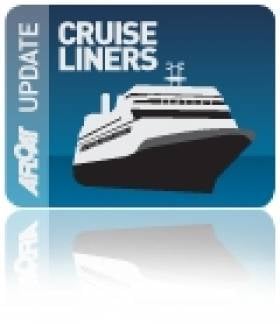Displaying items by tag: HapagLloyd Cruises
Cruise Quartet Call to Dublin Port Among them Brand New High-End Expedition Cruiseship
A quartet of cruiseships called to Dublin Port last week among them a brand new ship operating at the higher-end of the market for German based clientele, writes Jehan Ashmore.
The 15,560 gross tonnage newbuild named Hanseatic Nature had sailed from Douglas, Isle of Man.
Prior to this first call to Dublin Port on Thurday last week, a separate maiden commercial voyage of the 230 maximum cruise capacity newbuild took place earlier this month from Hamburg on 5th May. This following a naming ceremony the previous day held at the Cruise Center Altona.
Preceeding both naming ceremony and maiden cruise, Hanseatic Nature took a delivery voyage directly from the builder's yard of VARD Group A/S in Norway to make a debut at the German port on 3rd May.
Owners Hapag-Lloyd Cruises introduced Hanseatic Nature as the first of a trio of 'Expedition' class cruiseships to be followed by Hanseatic Inspiration in October and Hanseatic Spirit due in 2021.
According to the operator, classification from the Berlitz Cruise Guide is not currently available as this will be given once all the ships are completed. The operator however did add that they believe the comfort standard is similar to that their of Europa and Europa 2. Both of these cruiseships received the distinction of 5-stars-plus in the Berlitz Cruise Guide 2019.
The new luxury cruiseship has 7 passenger decks where facilities include a choice of three restaurants, bars and lounges and a pair of extendible glass balconies. This feature floats over the ocean with perfect views for example when watching whales and dolphins.
There is also a marine dock used for a variety of warmwater sports, from kayaking, stand-up paddle boarding (SUP-ing) in addition to snorkelling equipment.
Cabins and suites total 120. They all come equipped - for example with binoculars, Nordic Walking poles, air-conditioning, coffee machine and mini bar (free of charge).
Hapag-Lloyd claim the class offer more open deck space than on any other expedition ship to enable guests to see the sights and wonders of the world. This could be in the polar regions where those on board can hear the ice crack as you stand on the bow noting the cruiseship has an Ice classification PC6 – the highest ice class for passenger ships.
On cruises to the Antarctic expeditions and cruises around Spitsbergen, capacity is reduced to 199 guests who can avail of the 17 Zodiacs to make shore-based expedition excursions. Or an expedition cruise could be in the extreme opposite environment when navigating through dense mangrove forests of the Amazon as they pass by at arm’s length.
Hanseatic Nature and Hanseatic Spirit will conduct cruises as a German-speaking ship. As for the third sister, Hanseatic Inspiration however will be an international ship, with all cruises using both English and German.
So what about the other three cruiseships that called to Dublin Port?... Afloat below reveals the following visitors:
Cruise & Maritime Voyages / Transocean Astor had docked in Alexandra Basin having sailed overnight from Belfast Harbour.
Silverseas Cruises Silver Cloud also occupied a berth in Alexandra Basin but along Ocean Pier. This ultra-luxury visitor having sailed from Killybegs in Co. Donegal.
As for the third caller to the Irish capital port, this belonged to Grand Circle Line's Corinthian from Fishguard, Wales. Unlike the rest of the quartet, Corinthian sailed upriver to the Liffey quays, given its small size permitting a transit of the Tom Clarke (East-Link) bridge and a berth at Sir John Rogerson's Quay.
Returning to Hanseatic Nature which currently continues on the same cruise from Hamburg and which so far has included UK south coast ports among them off Cowes, Isle of Wight.
Today the newbuild called at the Dutch port of Oueschild on the island of Texal located off Den Helder on the mainland. The cruise will culminate with a return passage along the Elbe estuary before guests disembark in Hamburg this Saturday.
Bremen Visits Galway
#GALWAY CRUISE CALL– Following last month's first cruise call this season of Silver Explorer to Galway Docks, the city of the tribes welcomed the Bremen yesterday, writes Jehan Ashmore.
Unlike the Silver Explorer, operated by Silverseas Cruises, which transited through the narrow entrance into Dun Aengus Dock, the Bremen (1990/6,752grt) made an anchorage call offshore. The latter vessel which is operated by Hapag-Lloyd, has a four-star ranking according to the Berlitz Guide to Cruising 2012.
The small expedition ship takes her 164-guests who in comparison are served by a large crew numbering 100. The vessel visits some of the most beautiful and remote regions in the world which has included visiting both the poles at the Artic and Antarctica.
On this particular cruise, she had called to Kilronan, Inishmore on the Aran Islands and is currently underway heading for Tory Island.
The presence of the Silver Explorer, previously Prince Albert II, made for an interesting experience as Galwegians witnessed the vessel navigate skillfully through the tight confines of Dun Aengus dock system.
A further six cruise calls are scheduled, the next been Cruise & Maritime Voyages (CMV) Marco Polo, the classic cruiseship with her liner heritage is to make the port of call in July.





























































